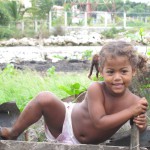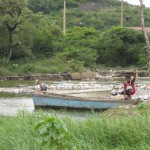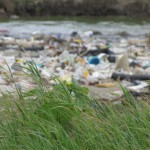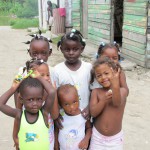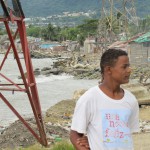As I sit here getting ready to tell you all about Agua Negra I realize it has been quite awhile since I have written or updated at all. This in mind I will give a brief sparknotes version of the last week of my life.
Last week I had the classic what am I doing here melt down. Liz and I had a great talk and the next day I finally got to see where the kids live; Agua Negra. I discovered my real love of teaching English as well. Sunday we left Haiti where we stayed for a few days and now I am back to my regularly scheduled programming.
So, back to Agua Negra. Agua Negra translated in Black Water as pretty much anyone could translate. Most of our families live there or in Playa Westa (West Beach) which is a mirror bario. The streets are dirt. There are newly paved elevated side walks that help to keep down the mud slide that occurs when it rains. There is no sewage system so often the streets are a mixture of dirt and sewage, the sidewalks help to keep everyone out of the mess. However, the sidewalks are far from perfect and often end in some areas where they are needed the most. They were also not built for the people. Agua Negra is a port city. Trade ships are always coming to port in Agua Negra, there was also once an active cruise ship presence. Puerto Plata is a tourist city in many respects and the country would love to again attract cruise ships to this area. Agua Negra, being the first thing you see, needs all the help it can get.
The houses are no bigger than most average American bedrooms. Cement floors and walls that are poorly constructed are typical and when built too close to the coast have been swept away. Roofs are tin panels hammered or held down by rocks or rope. When the water does rise families can only open their doors and let the water run through in an attempt to save their home. If it does get swept away hopefully you have family you can room with because there is no government program or housing you can enter into. Most families have 5 to 15 living in one of these homes. Inside the house the rooms may be sectioned by cement walls or cardboard, maybe wood panels.
There is no real electricity in Agua Negra. The bario is next to a port and power plant where everyone splices power from. This forces the rest of the city to experience random power outages. The power plant will shut down power to the city in order to save money since so many people have electricity but dont pay for it.
I have never seen a beach like that of Agua Negra. Trash as far as you can see. Floating in the water, covering the beach; trash is everywhere. It is a very overwhelming sight. The water is black from pollution from ships, sewage and trash. You can see where it changes color in the ocean. There are other mission organizations working there.
Pastor Jacob has a church for Haitian kids living in the Dominican. Dominicans do not like Haitians. Haiti invaded the DR twice and once occupied for 25 years. During the occupation Haiti closed the schools and opened the prisons. There have been bad feeling ever since. Haitian kids are teased for looking different and most have a very hard time getting jobs. In Agua Negra there are still not necessarily considered Dominican, but neighbors help neighbors regardless. What Pastor Jacob does is teach the Haitian kids Spanish so that they can transfer into a regular school.
I know there are probably so many thing I am leaving out. The families I met there were sweet wonderful people. There are for sure problems in the families, but there is always hope. Comment me questions and I’ll try to cover what I missed!
